There’s more to uncontrolled asthma: Dupixent goes beyond addressing EOS and does more to impact type 2 inflammation1-3
DUPIXENT HAS A LEGACY ACROSS CONDITIONS EXHIBITING TYPE 2 INFLAMMATION, WITH ONE MILLION PATIENTS ON THERAPY WORLDWIDE ACROSS ALL INDICATIONS1,8,9,f |
a Systemic eosinophilic and allergic inflammation and local airway inflammation.
b Improvement in FEV1 at Week 2 (primary endpoint was Week 12); sustained through Week 52 (QUEST) and ~3 years (TRAVERSE OLE); exacerbation reduction through Week 52 (QUEST); reduced FeNO, mucus plugging, and airway resistance and increased airway volume at Week 24 (VESTIGE).
c 550 mL improvement in FEV1 at Week 52 with DUPIXENT 200/300 mg + SOC (n=69) in patients with EOS ≥300, FeNO ≥25, and allergic asthma on high-dose ICS.
d 75% reduction in annualized severe exacerbations at Week 52 with DUPIXENT 200/300 mg + SOC (n=91) in patients with EOS ≥300, FeNO ≥25, and allergic asthma on high-dose ICS.
e 86% of patients reduced or eliminated OCS use by Week 24 with DUPIXENT 300 mg + SOC (n=103) vs 68% with placebo + SOC (n=107) (P<0.001).
f ~1,000,000 patients on therapy worldwide across indications: atopic dermatitis, asthma, chronic rhinosinusitis with nasal polyps, prurigo nodularis, eosinophilic esophagitis,chronic obstructive pulmonary disease. Before prescribing the product, always refer to the prescribing information available in your country.
INDICATIONS
DUPIXENT is indicated in adults and adolescents 12 years and older as add-on maintenance treatment for severe asthma with type 2 inflammation characterised by raised blood eosinophils and/or raised fraction of exhaled nitric oxide (FeNO), who are inadequately controlled with high dose inhaled corticosteroids (ICS) plus another medicinal product for maintenance treatment.
DUPIXENT is indicated in children 6 to 11 years old as add-on maintenance treatment for severe asthma with type 2 inflammation characterised by raised blood eosinophils and/or raised fraction of exhaled nitric oxide (FeNO), who are inadequately controlled with medium to high dose inhaled corticosteroids (ICS) plus another medicinal product for maintenance treatment.
For additional information, please click here for the SmPC.
MOD
IL-4 AND IL-13 ARE KEY AND CENTRAL DRIVERS OF TYPE 2 INFLAMMATION
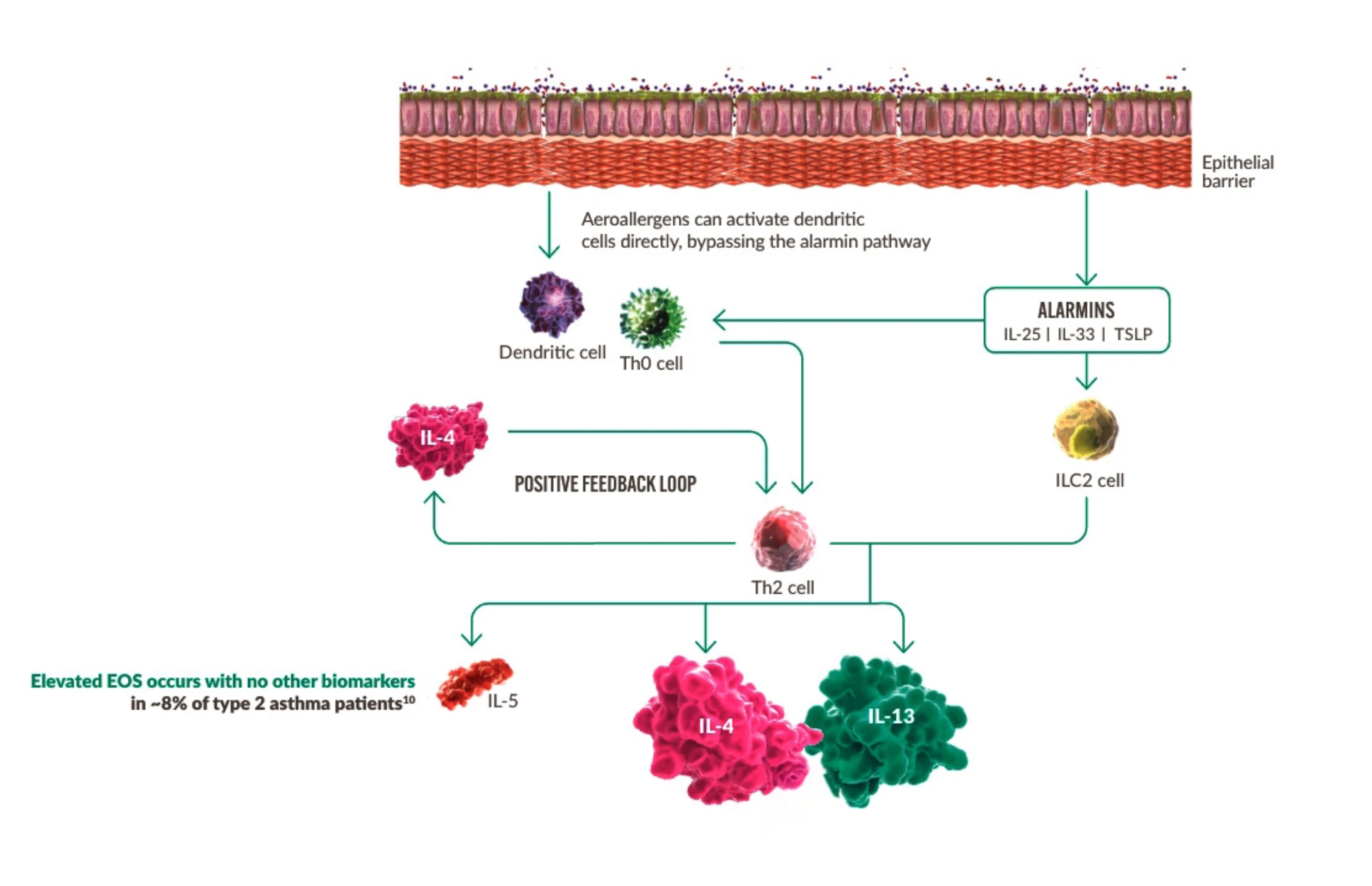.webp)
IL-4 and IL-13 contribute to systemic eosinophilic and allergic inflammation and local inflammatory effects2,11 |
MOA
MORE PRECISION TO TARGET BOTH IL-4 AND IL-13 TO IMPACT TYPE 2 INFLAMMATION AT THE SOURCE
|
SYSTEMIC INFLAMMATION Reduces Type 2 Biomarkers1,2,11-17 |
SYSTEMIC INFLAMMATION Improves Airway Structures1,2,11-17 |
|
Allergic inflammationa
Eosinophilic inflammationa
IL-5 plays a role in eosinophilic inflammation |
|
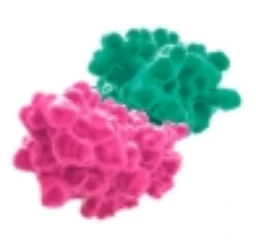
DUPIXENT goes beyond addressing EOS by precisely targeting IL-4 and IL-13 to protect against structural airway damage and disease progression1-3
a Systemic eosinophilic and allergic inflammation and local airway inflammation.
MORE POSSIBILITIES FOR PATIENTS WITH TYPE 2 ASTHMA
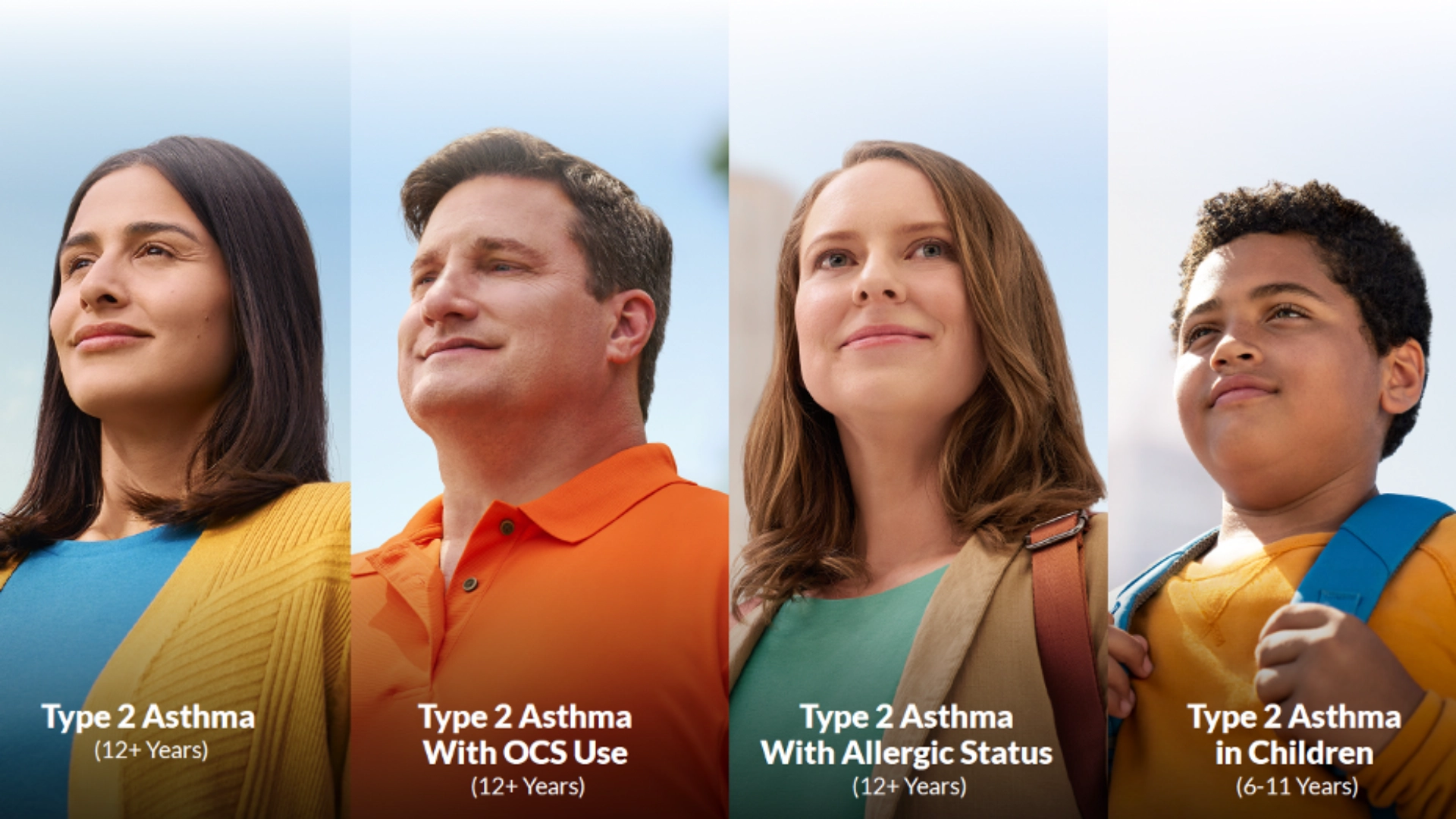
Patient profiles are representative and are not actual patients. Individual results may vary.
Type 2 Asthma (12+)
DUPIXENT GOES BEYOND EOS TO DO MORE FOR PATIENTS WITH TYPE 2 ASTHMA

Meet Sophia | Age 35
EOS 370 cells/μL, IgE 270 IU, FeNO 15 ppb
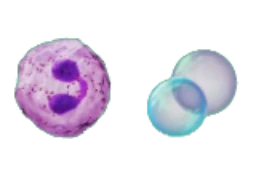
IDENTIFY TYPE 2 ASTHMA: ELEVATED EOS AND/OR ELEVATED FeNO, REGARDLESS OF ALLERGIC STATUS

75% reduction in annualized severe exacerbations5;a

67% of DUPIXENT patients reduced or eliminated mucus plugs7
~3 years
of sustained breathing relief patients can feel18,b
90%
of patients experienced zero exacerbations19,c
59%
of type 2 asthma patients have more than one elevated type 2 biomarker10,a
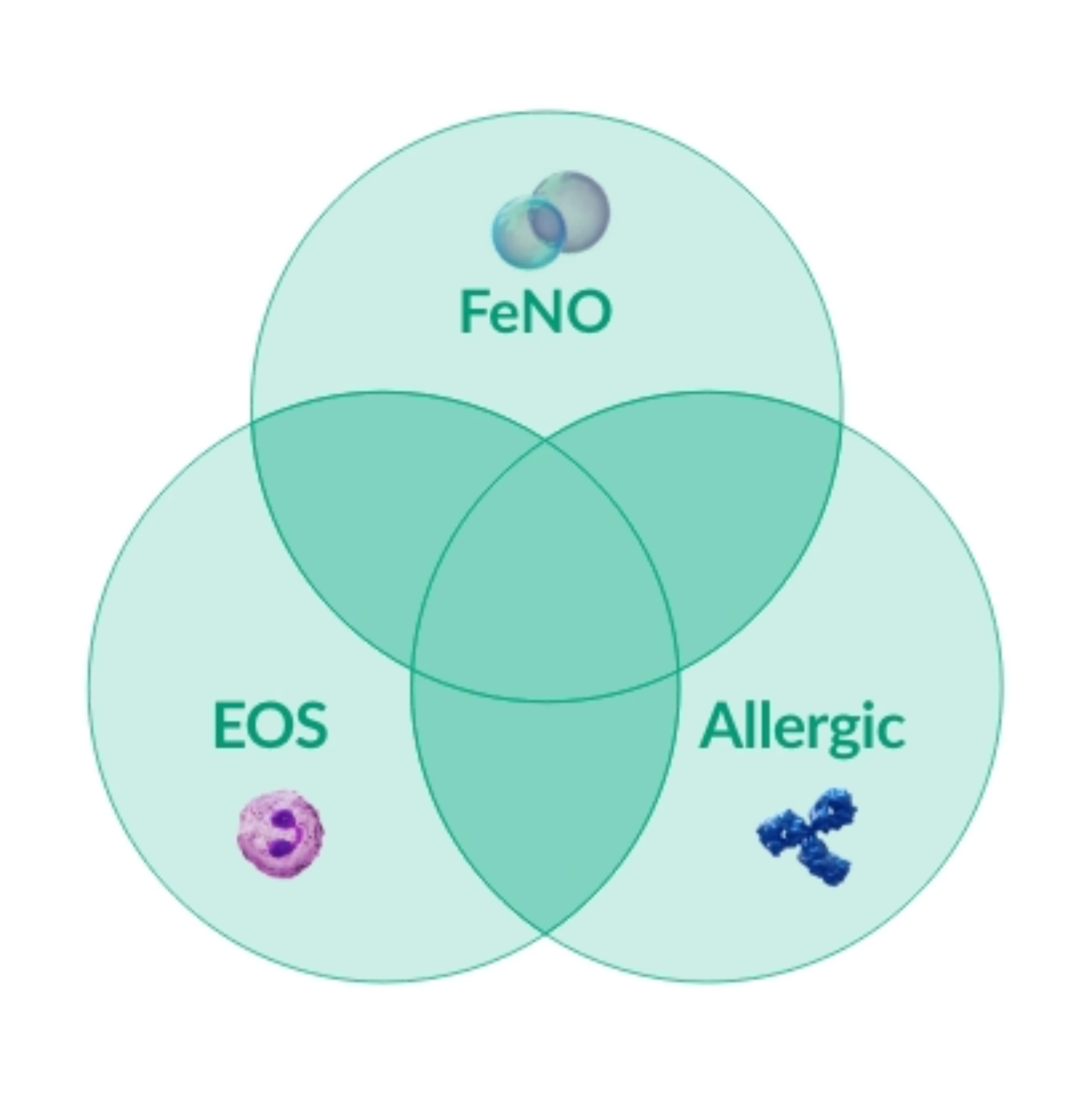
Elevated EOS occurs with no other biomarkers in ~8% of type 2 asthma patients10
a Within the international Severe Asthma Registry, (ISAR) data were analyzed in adults with severe asthma with available biomarkers (n=1,175) from 10 countries in North America, Europe, and Asia, with respecified thresholds for biomarker positivity— (serum IgE ≥75 IU/mL, blood eosinophils ≥300 cells/μL, and FeNO ≥25 ppb); and with hierarchical cluster analysis using biomarkers as continuous variables. Distinct clusters were shown with significant overlap of biomarker positivity in severe asthma.
Type 2 Asthma With OCS Use (12+)
DUPIXENT DOES MORE FOR TYPE 2 ASTHMA PATIENTS WHO USE OCS

Meet Marco | Age 41
EOS 110 cells/μL; IgE 72 IU; FeNO 20 ppb

THE FIRST OCS BURST IS THE FIRST SIGN TO ASSESS FOR TYPE 2 ASTHMA1,3,19-21

94% of patients maintained complete elimination19,d

250 mL improvement in lung function19,e

90% were exacerbation-free19,f
Type 2 Asthma With Allergic Phenotype (12+)
DUPIXENT DOES MORE FOR PATIENTS WITH ALLERGIC STATUS

Meet Emma | Age 38
EOS 140 cells/μL; IgE 325 IU; FeNO 33 ppb

DUPIXENT IS EFFECTIVE IN PATIENTS WITH ALLERGIC STATUS WHO HAVE ELEVATED EOS AND/OR ELEVATED FeNO
EOS + Allergic

470 mL improvement in lung function5,g
FeNO + Allergic

470 mL improvement in lung function5,h
EOS + FeNO + Allergic

550 mL improvement in lung function5,i
Type 2 Asthma in Children (6-11)
DUPIXENT DOES MORE FOR CHILDREN WITH TYPE 2 ASTHMA

Meet Robert | Age 10
EOS 305 cells/μL; IgE 22 IU; FeNO 30 ppb

IDENTIFY TYPE 2 ASTHMA: ELEVATED EOS AND/OR ELEVATED FeNO, REGARDLESS OF ALLERGIC STATUS

470 mL improvement in lung function20,j

66% reduction in exacerbation20,k
a 75% reduction in annualized severe exacerbations at Week 52 with DUPIXENT 200/300 mg + SOC (n=91) in patients with EOS ≥300, FeNO ≥25, and allergic asthma on high-dose ICS.
b As observed across a 52-week trial (QUEST) and a 96-week, open-label extension trial (TRAVERSE) of adult and adolescent patients.
c 89% of patients from QUEST experienced zero exacerbations in Year 3 (Weeks 48-96) when treated with DUPIXENT 200 mg/300 mg Q2W + SOC (n=816) for 52 weeks in Trial 2 (QUEST) and continued with DUPIXENT 300 mg Q2W + SOC in the OLE period (other endpoint).
d At Week 24 of VENTURE, 48 of 90 in the DUPIXENT/DUPIXENT patient group (53.3%) and 29 of 97 in the placebo/DUPIXENT patient group (29.9%) were free of OCS treatment. Of these, 31 of 33 in the DUPIXENT/DUPIXENT patient group and 21 of 21 in the placebo/DUPIXENT patient group with available OCS dose data remained free of OCS treatment at TRAVERSE Week 48. 14 of 14 in the DUPIXENT/DUPIXENT patient group and 9 of 9 in the placebo/DUPIXENT patient group continued to be free of OCS treatment at TRAVERSE Week 96.
e 250 mL improvement in FEV1 at Week 96 of TRAVERSE from VENTURE baseline in the DUPIXENT/DUPIXENT patient group (n=28) vs 360 mL in the placebo/DUPIXENT patient group (n=32).
f Of the 67 DUPIXENT/DUPIXENT patients who were treated up to 96 weeks in TRAVERSE, 90% were exacerbation-free during Weeks 48 through 96 of TRAVERSE.
g 470 mL improvement in FEV1 at Week 52 with DUPIXENT 200/300 mg + SOC (n=141) vs 170 mL with placebo + SOC (n=93) (LSM difference, 290 mL [95% CI: 180, 400 mL]) in patients with EOS ≥300 and allergic asthma on high-dose ICS.
h 470 mL improvement in FEV1 at Week 52 with DUPIXENT 200/300 mg + SOC (n=165) vs 180 mL with placebo + SOC (n=99) (LSM difference, 290 mL [95% CI: 180, 400 mL]) in patients with FeNO ≥25 and allergic asthma on high-dose ICS.
i 550 mL improvement in FEV1 at Week 52 with DUPIXENT 200/300 mg + SOC (n=91) vs 210 mL with placebo + SOC (n=64) (LSM difference, 340 mL [95% CI: 200, 470 mL]) in patients with EOS ≥300, FeNO ≥25, and allergic asthma on high-dose ICS.
j 470 mL improvement in FEV1 at Week 52 with DUPIXENT 100/200 mg + SOC (n=123) vs 240 mL with placebo + SOC (n=53) (LSM difference, 220 mL [95% CI: 110, 330 mL]) in pediatric patients with FeNO ≥20 and allergic asthma on medium- to high-dose ICS.
k 66% reduction in annualized severe exacerbations at Week 52 with DUPIXENT 100/200 mg + SOC (n=114) vs placebo + SOC (n=52) (0.190 vs 0.599) (P=0.0003) in pediatric patients with EOS ≥300 and FeNO ≥20 on medium- to high-dose ICS.
l Most children (286 [91%] of 315) remained exacerbation-free throughout the study.
Lung Function (>1 biomarker, FeNO, EOS)
>1 biomarker

EOS + Allergic
440 mL improvementa
EOS + FeNO
530 mL improvementb
FeNO + Allergic
440 mL improvement c
EOS + FeNO + Allergic
500 mL improvementd

SOME PATIENTS GAINED MORE THAN A HALF-LITER IMPROVEMENT IN LUNG FUNCTION5
a 440 mL improvement in pre-BD FEV1 from baseline at Year 3 with DUPIXENT 300 mg Q2W (n=51) in patients with EOS ≥300 and allergic asthma on high-dose ICS.
b 530 mL improvement in pre-BD FEV1 from baseline at Year 3 with DUPIXENT 300 mg Q2W (n=70) in patients with EOS ≥300 and FeNO ≥25 on high-dose ICS.
c 440 mL improvement in pre-BD FEV1 from baseline at Year 3 with DUPIXENT 300 mg Q2W (n=57) in patients with FeNO ≥25 and allergic asthma on high-dose ICS.
d 500 mL improvement in pre-BD FEV1 from baseline at Year 3 with DUPIXENT 300 mg Q2W (n=34) in patients with EOS ≥300, FeNO ≥25 and allergic asthma on high-dose ICS.
Elevated FeNO
BETTER BREATHING MEANS MORE POSSIBILITIES FOR TYPE 2 ASTHMA PATIENTS WITH ELEVATED FeNO
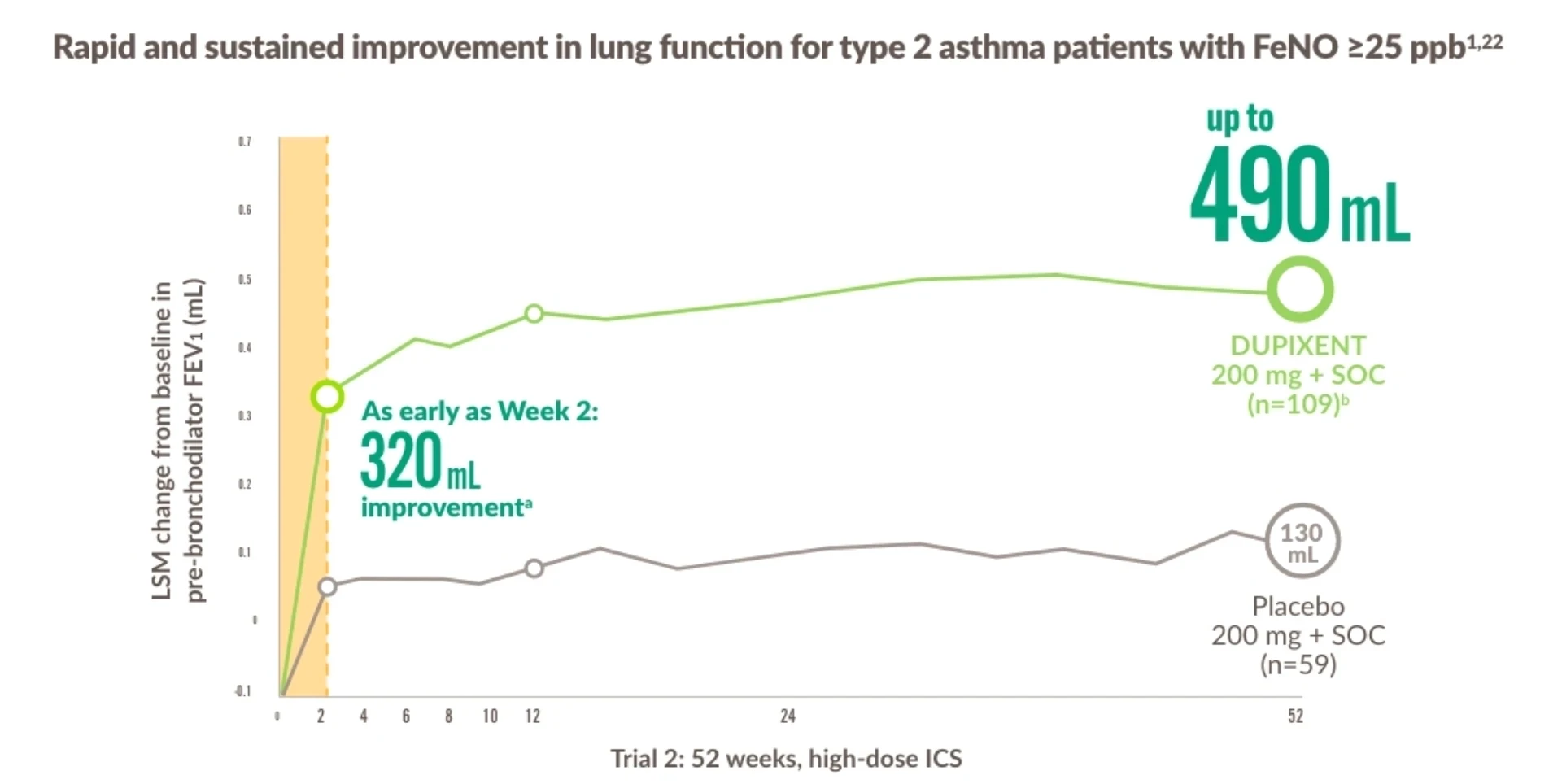
~3 YEARS OF SUSTAINED RELIEF was seen in the OLE study18,c

PER GINA, ELEVATED FeNO IS STRONGLY PREDICTIVE OF TREATMENT RESPONSE WITH DUPIXENT23
a Primary endpoint was Week 12.
b LSM difference, 360 mL (95% CI: 230, 480 mL).
c As observed across a 52-week trial (QUEST) and a 96-week, open-label extension trial (TRAVERSE) of adult and adolescent patients.
In patients with EOS ≥500 cells/μL

490 mL improvement in FEV1 at Week 525,a
a 490 mL improvement in pre-BD FEV1 from baseline at Week 52 with DUPIXENT 300 mg Q2W (n=115) in patients with EOS ≥500 on high-dose ICS.
Elevated EOS
BETTER BREATHING MEANS MORE POSSIBILITIES FOR PATIENTS WITH ELEVATED EOS
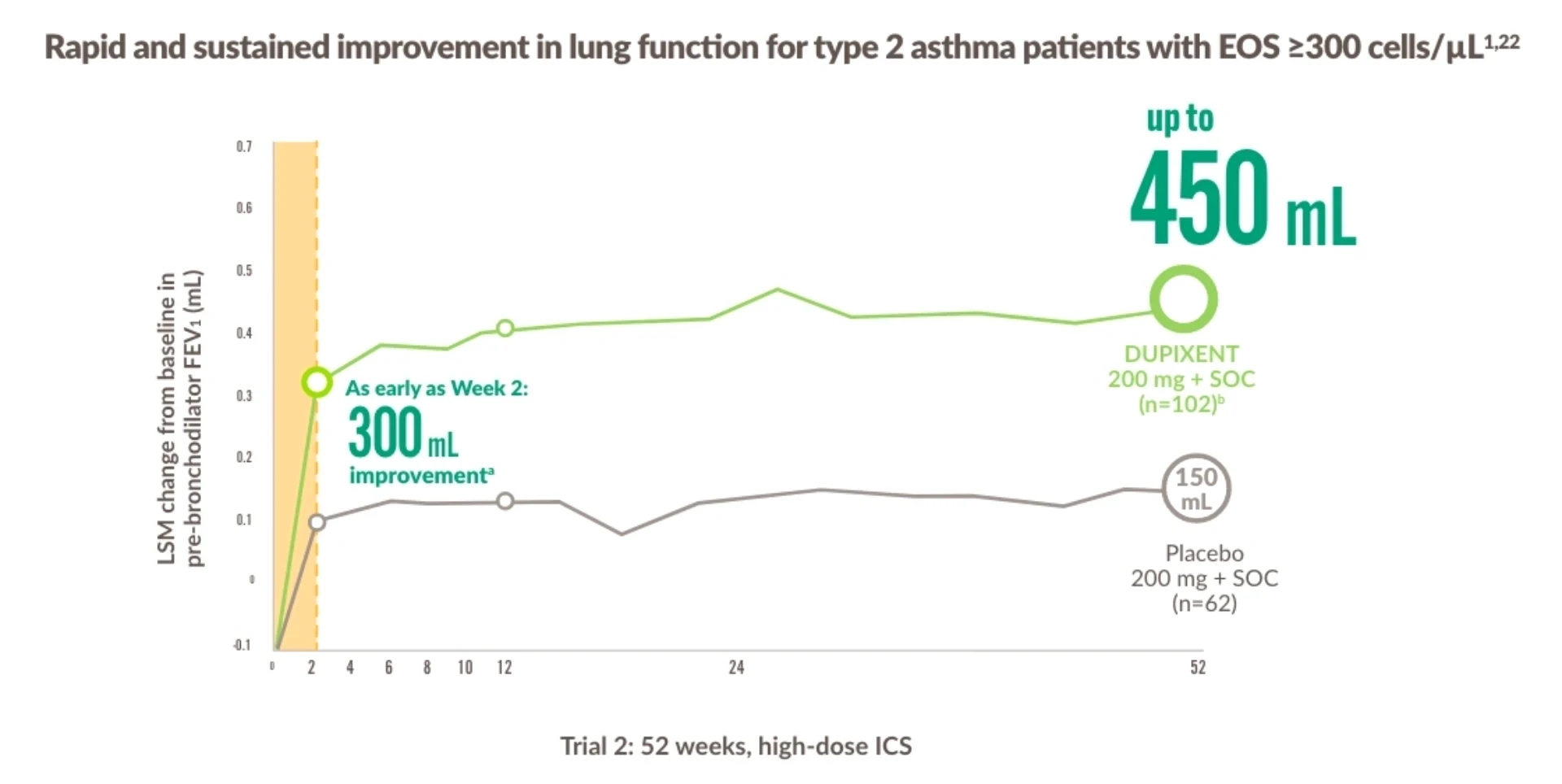
~3 YEARS OF SUSTAINED RELIEF was seen in the OLE study18,c

PER GINA, ELEVATED EOS IS STRONGLY PREDICTIVE OF TREATMENT RESPONSE WITH DUPIXENT23
a Primary endpoint was Week 12.
b LSM difference, 360 mL (95% CI: 230, 480 mL).
c As observed across a 52-week trial (QUEST) and a 96-week, open-label extension trial (TRAVERSE) of adult and adolescent patients.
In patients with EOS ≥500 cells/μL

490 mL improvement in FEV1 at Week 525,a
a 490 mL improvement in pre-BD FEV1 from baseline at Week 52 with DUPIXENT 300 mg Q2W (n=115) in patients with EOS ≥500 on high-dose ICS.
Exacerbations (>1 biomarker, FeNO, EOS)
>1 biomarker
MORE FREEDOM FROM EXACERBATIONS ACROSS PATIENTS WITH TYPE 2 ASTHMA
In a post-hoc analysis, patients with more than one elevated biomarker had significant exacerbation reductions at Week 525

Patient profiles are representative and are not actual patients. Individual results may vary.
EOS + Allergic

59% reductiona
EOS + FeNO

73% reductionb
FeNO + Allergic

64% reduction c
EOS + FeNO + Allergic

75% reductiond
a 59% reduction in annualized severe exacerbations at Week 52 with DUPIXENT 200/300 mg + SOC (n=141) vs placebo + SOC (n=93) (0.270 vs 0.612) (P<0.0001) in patients with EOS ≥300 and allergic asthma on high-dose ICS.
b 73% reduction in annualized severe exacerbations at Week 52 with DUPIXENT 200/300 mg + SOC (n=180) vs placebo + SOC (n=104) (0.189 vs 0.396) (P<0.0001) in patients with EOS ≥300 and FeNO ≥25 on high-dose ICS.
c 64% reduction in annualized severe exacerbations at Week 52 with DUPIXENT 200/300 mg + SOC (n=165) vs placebo + SOC (n=99) and (0.241 vs 0.534) (P<0.0001) in patients with FeNO ≥25 and allergic asthma on high-dose ICS.
d 75% reduction in annualized severe exacerbations at Week 52 with DUPIXENT 200/300 mg + SOC (n=91) vs placebo + SOC (n=64) (0.152 vs 0.412) (P<0.0001) in patients with EOS ≥300, FeNO ≥25, and allergic asthma on high-dose ICS.
Elevated FeNO
MORE FREEDOM FROM EXACERBATIONS FOR PATIENTS WITH ELEVATED FeNO
Significant exacerbation reduction for type 2 asthma patients with FeNO ≥25 ppb at Week 52, sustained for ~3 years18,22

Patient profiles are representative and are not actual patients. Individual results may vary.

69% reduction24,a
~3 YEARS OF SUSTAINED PROTECTION was seen in the OLE study18,b

PER GINA, ELEVATED FeNO IS STRONGLY PREDICTIVE OF TREATMENT RESPONSE WITH DUPIXENT23
a In annualized severe exacerbations at Week 52 (QUEST) with DUPIXENT 200 mg + SOC (n=145) vs placebo + SOC (n=78) (0.40 vs 1.30) (P<0.001), and 55% reduction with DUPIXENT 300 mg + SOC (n=159) vs placebo + SOC (n=89) (0.57 vs 1.26) (P<0.001).
b As observed across a 52-week trial (QUEST) and a 96-week, open-label extension trial (TRAVERSE) of adult and adolescent patients.
A severe exacerbation event was defined as a deterioration of asthma requiring the use of systemic corticosteroids for ≥3 days or hospitalization or an ED visit.
The population in dupilumab asthma trials included patients on medium- to high-dose ICS. All data presented above represent the high-dose ICS population.
Elevated EOS
MORE FREEDOM FROM EXACERBATIONS FOR PATIENTS WITH ELEVATED EOS
Significant exacerbation reduction for type 2 asthma patients with elevated baseline EOS at Week 52, sustained for ~3 years

Patient profiles are representative and are not actual patients. Individual results may vary.
EOS ≥150 cells/μL

55% reduction22,a
EOS ≥300 cells/μL

66% reduction22,a
EOS ≥500 cells/μL

70% reduction5,c
~3 YEARS OF SUSTAINED PROTECTION was seen in the OLE study18,d

PER GINA, ELEVATED EOS IS STRONGLY PREDICTIVE OF TREATMENT RESPONSE WITH DUPIXENT23
a In annualized severe exacerbations at Week 52 with DUPIXENT 200 mg + SOC (n=223) vs placebo + SOC (n=126) (0.56 vs 1.24) (P<0.001), and up to 53% reduction with DUPIXENT 300 mg + SOC (n=228) vs placebo + SOC (n=127) (0.53 vs 1.15) (P<0.001).
b In annualized severe exacerbations at Week 52 with DUPIXENT 300 mg + SOC (n=144) vs placebo + SOC (n=79) (0.51 vs 1.48) (P<0.001), and up to 59% reduction with DUPIXENT 200 mg + SOC (n=128) vs placebo + SOC (n=80) (0.55 vs 1.35) (P<0.001).
c As observed across a 52-week trial (QUEST) and a 96-week, open-label extension trial (TRAVERSE) of adult and adolescent patients.
d As observed across a 52-week trial (QUEST) and a 96-week, open-label extension trial (TRAVERSE) of adult and adolescent patients.
A severe exacerbation event was defined as a deterioration of asthma requiring the use of systemic corticosteroids for ≥3 days or hospitalization or an ED visit.
The population in dupilumab asthma trials included patients on medium- to high-dose ICS. All data presented above represent the high-dose ICS population.
QUEST was a randomized, double-blind, placebo-controlled, parallel-group trial that assessed the efficacy of DUPIXENT in 1,902 patients 12 years of age or older patients with uncontrolled, moderate-to-severe asthma. The primary endpoints were the annualized rate of severe asthma exacerbations and the absolute change from baseline to Week 12 in FEV1 before bronchodilator use in the overall trial population. Secondary endpoints included the exacerbation rate and FEV1 in patients with a blood eosinophil count of 300 or more per cubic millimeter. Asthma control and DUPIXENT safety were also assessed.
TRAVERSE was an open-label extension study that assessed the safety and efficacy of DUPIXENT 300 mg every 2 weeks up to 96 weeks in adults and adolescents (aged 12- 84 years) with moderate-to-severe or oral-corticosteroid–dependent severe asthma who had completed a previous DUPIXENT asthma study (including QUEST). The primary endpoint was the number and percentage of patients with any treatment-emergent adverse events. Secondary endpoints included an annualized exacerbation rate (AER) over the treatment period and change from parent study baseline in pre-bronchodilator FEV1.
OCS Elimination (24 weeks, 49-58 weeks)
24 weeks
DUPIXENT DOES MORE TO ELIMINATE OCS

Patient profiles are representative and are not actual patients. Individual results may vary.
52% of patients completely eliminated OCS by Week 24 in the VENTURE study1,19,24
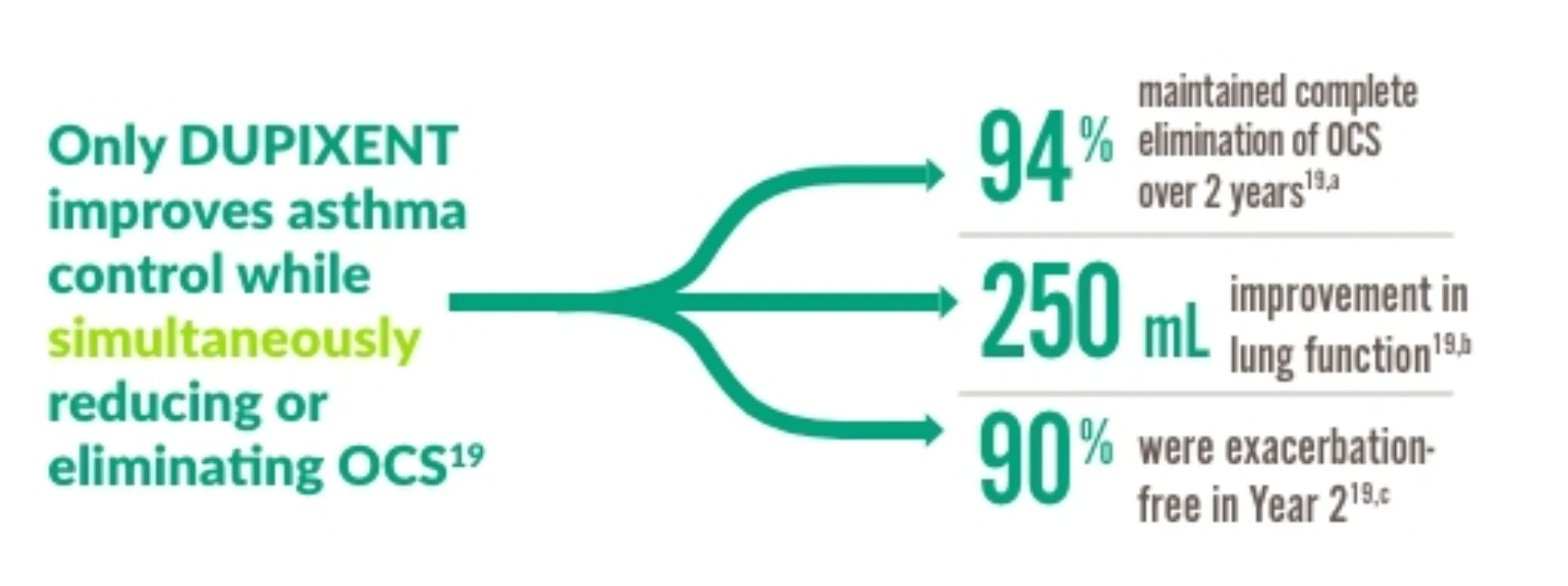.webp)

DUPIXENT IS THE ONLY GINA-RECOMMENDED BIOLOGIC FOR OCS USERS23
a 86% of patients reduced or eliminated OCS use by Week 24 with DUPIXENT 300 mg + SOC (n=103) vs 68% with placebo + SOC (n=107) (P<0.001).
b 220 mL improvement in pre-bronchodilator FEV1 at Week 24 with DUPIXENT 300 mg + SOC (n=103) vs 10 mL with placebo + SOC (n=107) (LSM difference, 220 mL [95% CI: 90, 340 mL]).
c 59% reduction in annualized rate of severe exacerbations at Week 24 with DUPIXENT 300 mg + SOC (n=103) vs placebo + SOC (n=107) (0.65 vs 1.60; rate ratio: 0.41 [95% CI: 0.26, 0.63]).
49-58 weeks
DUPIXENT DOES MORE TO ENSURE PATIENTS REMAIN OCS FREE

Patient profiles are representative and are not actual patients. Individual results may vary.
Complete elimination of OCS achieved through Week 24 and sustained through Week 9619
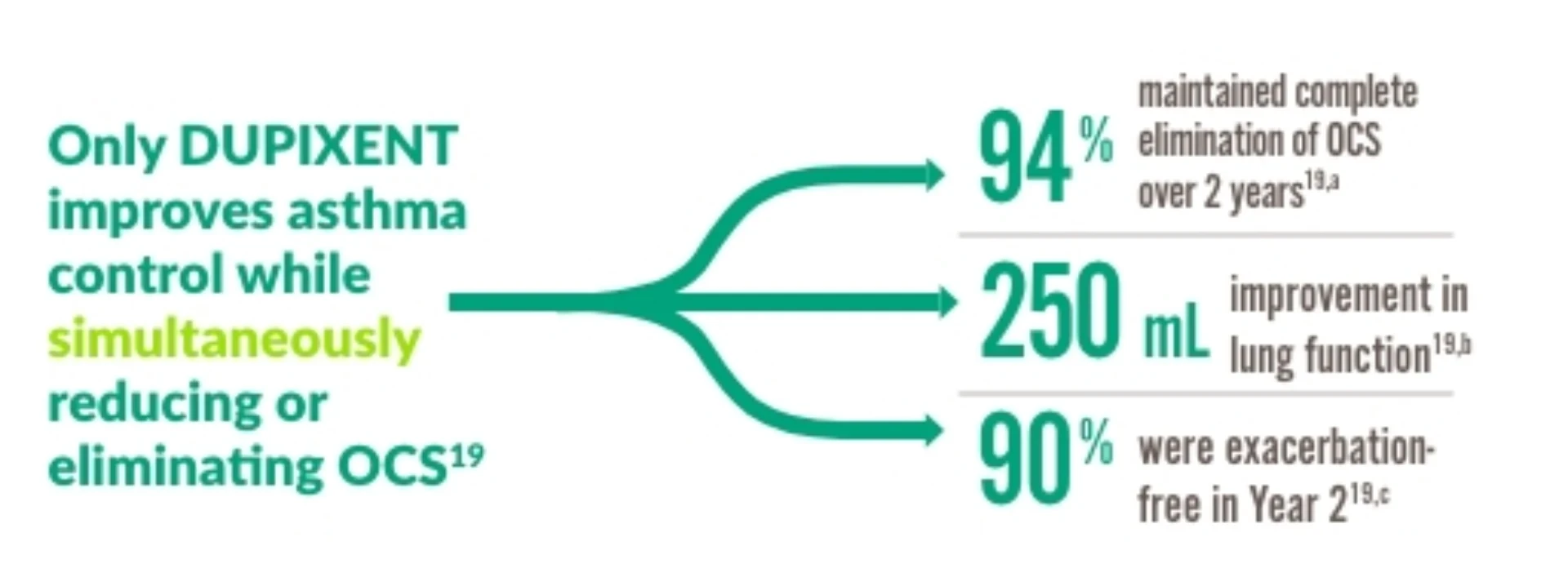.webp)

DUPIXENT IS THE ONLY GINA-RECOMMENDED BIOLOGIC FOR OCS USERS23
a 86% of patients reduced or eliminated OCS use by Week 24 with DUPIXENT 300 mg + SOC (n=103) vs 68% with placebo + SOC (n=107) (P<0.001).
b 220 mL improvement in pre-bronchodilator FEV1 at Week 24 with DUPIXENT 300 mg + SOC (n=103) vs 10 mL with placebo + SOC (n=107) (LSM difference, 220 mL [95% CI: 90, 340 mL]).
c 59% reduction in annualized rate of severe exacerbations at Week 24 with DUPIXENT 300 mg + SOC (n=103) vs placebo + SOC (n=107) (0.65 vs 1.60; rate ratio: 0.41 [95% CI: 0.26, 0.63]).
Mucus Plugs (VESTIGE study is not added yet in to the local label in Kingdom of Saudi Arabia)
DUPIXENT DOES MORE TO CLEAR MUCUS PLUGS
Mucus plug reduction is strongly correlated with lung function improvement4,6,25
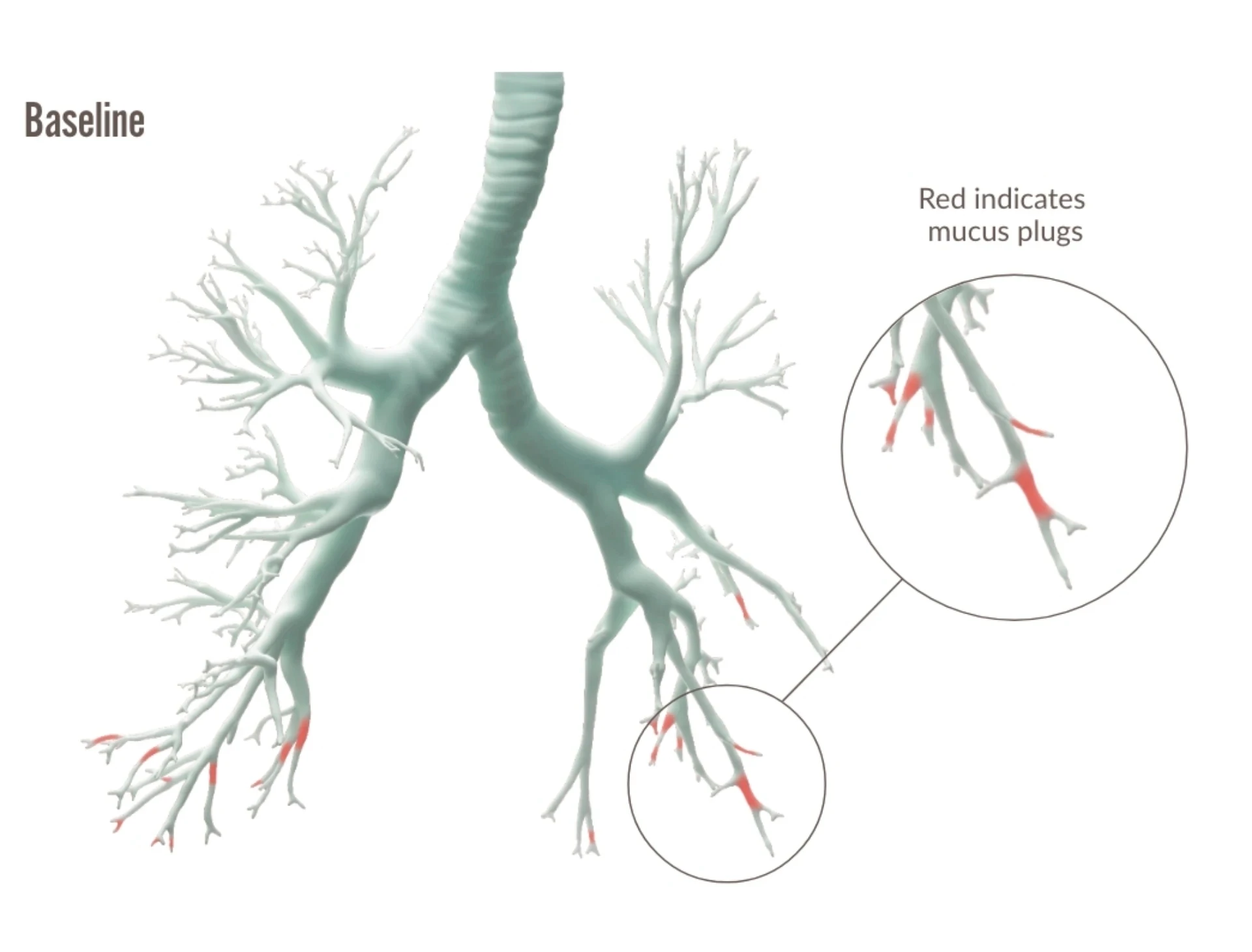
Individual images correspond to patients with the median change in the high- dose ICS population.
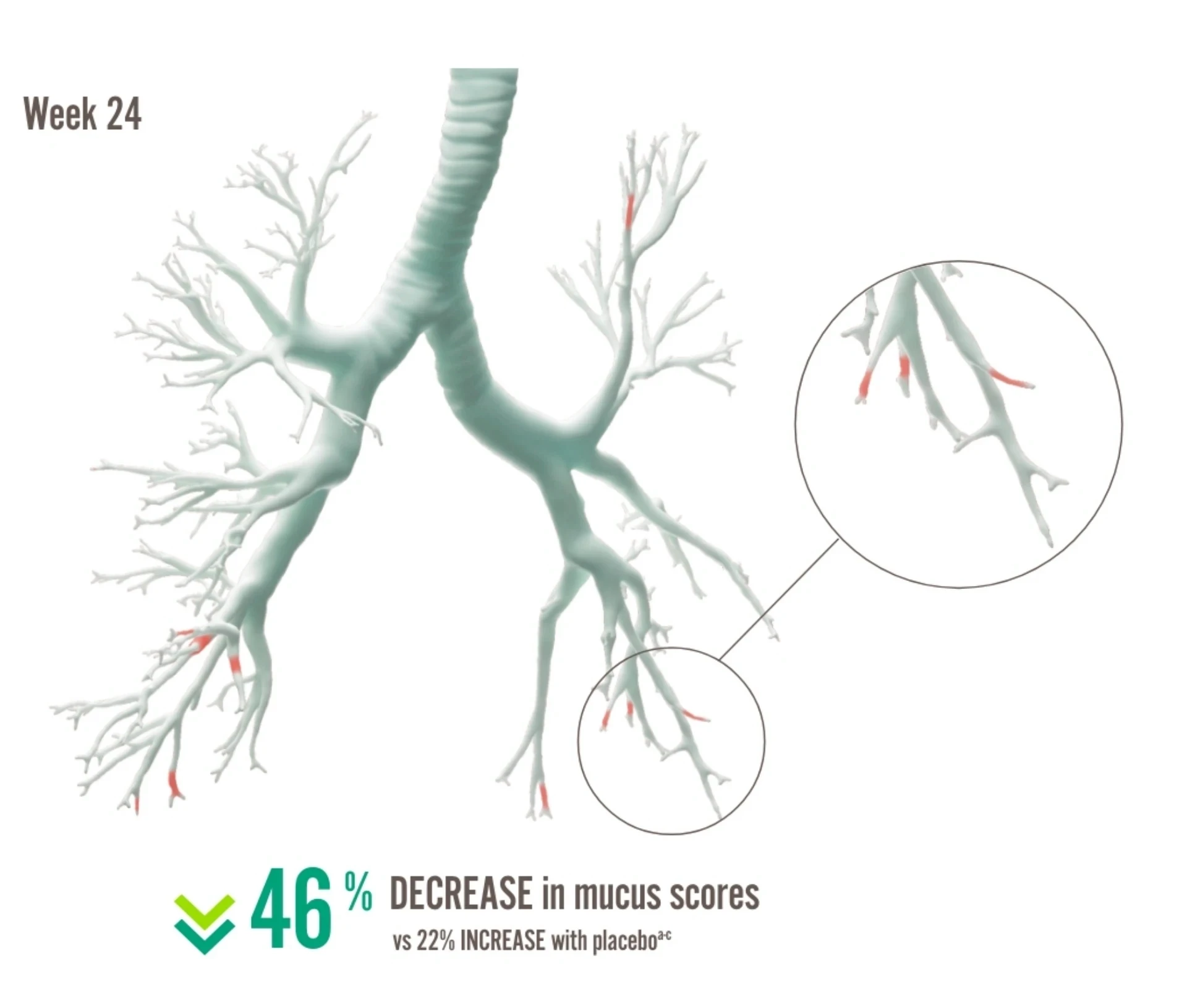

67% of DUPIXENT patients reduced or eliminated mucus plugs7
- 660 mL improvement in pre-BD FEV1 vs 270 mL with placebo26,d
- 48% improvement in ACQ-7 from baseline27,e
a In the high-dose ICS population, 3.8 decrease in global mucus score at Week 24 from baseline score of 8.3 with DUPIXENT 300 mg + SOC (n=34) vs 1.5 increase from baseline score of 6.9 with placebo + SOC (n=21) (LSM difference: -5.3 [95% CI: - 7.704, -2.821], nominal P<0.0001).
b Mucus scores range from 0 to 20, with higher scores indicating airway occlusion. Scores between 0.5 to 3.5 indicate low mucus levels, and scores between 4 and 20 indicate high mucus levels.26
c In the ITT population, 3.48 decrease in global mucus score at Week 24 from baseline score of 7.2 with DUPIXENT 300 mg + SOC (n=72) vs 1.44 increase from baseline score of 6.9 with placebo + SOC (n=37) (LSM difference: -4.92 [0.80]), nominal P<0.001.
d Pearson’s correlation coefficient for mucus score/pre-BD FEV1: r[60]=-0.61, nominal P<0.001.
e LS mean change in ACQ-7 score from baseline at Week 24: -1.4 from 2.9 at baseline with DUPIXENT + SOC (n=72) vs -0.6 from 3.0 at baseline with placebo + SOC (n=37) (LSM difference vs placebo: -0.7 [95% CI: -1.1, -0.4]; nominal P<0.001).
The VESTIGE trial was a phase 4, randomized, double-blind, placebo-controlled study that used functional respiratory imaging (FRI) to evaluate the effect of dupilumab on airway inflammation, as well as structural and functional changes in the lungs. The primary endpoints were proportion of patients achieving FeNO <25 ppb at Week 24, and change from baseline to Week 24 in airway volume. Secondary endpoints included change in global mucus score from baseline at Week 24 determined by high-resolution computed tomography (HRCT), and change from baseline in airway resistance.
ACQ-5 and AQLQ
DUPIXENT DOES MORE TO IMPROVE ASTHMA CONTROL AND QUALITY OF LIFE
Significantly improved ACQ-5 and AQLQ(S) scores in patients with type 2 asthma at Week 521,a

Patient profiles are representative and are not actual patients. Individual results may vary.
ACQ-5

76% of patients improved asthma controlb
AQLQ(S)

71% of patients improved QoLc
a The responder rate was defined as an improvement in core of 0.5 or more (scale range 0-6 for ACQ-5 and 1-7 for AQLQ[S]).
b 76% ACQ-5 responders within ACQ-5 with DUPIXENT 300 mg + SOC (n=277) vs 64% with placebo + SOC (n=159), and 74% with DUPIXENT 200 mg + SOC (n=262) vs 65% with placebo + SOC (n=141) in patients on medium-to-high dose ICS with FeNO ≥25.
c 71% AQLQ(S) responders with DUPIXENT 300 mg + SOC (n=239) vs 55% with placebo + SOC (n=124), and 65% with DUPIXENT 300 mg + SOC (n=248) vs 55% with placebo + SOC (n=129) in patients on medium-to-high dose ICS with EOS ≥300.
DUPIXENT significantly improved ACQ-5 scores1
QUEST was a 52-week randomized, double-blind, placebo-controlled, parallel-group trial that assessed the efficacy of DUPIXENT in 1,902 patients (12 years of age or older) with uncontrolled, moderate-to-severe asthma on a medium to high dose of ICS and a second controller (+/- a third controller). Subjects were randomized to receive either 200 mg or 300 mg DUPIXENT Q2W (or matching placebo for either 200 mg or 300 mg). following an initial dose of 400 mg, 600 mg, or placebo, respectively. The primary endpoints were the annualized rate of severe asthma exacerbations during the 52-week period and the absolute change from baseline to Week 12 in pre-bronchodilator FEV1 in the overall population. Secondary endpoints included the annualized exacerbation rate and pre-BD FEV1 in patients with a blood eosinophil count of 300 or more per microliter, as well as responder rates in the ACQ-5 and AQLQ(S), and safety.
Study Designs (adolescents/adults, children)
adolescents/adults
DUPIXENT WAS STUDIED IN A CLINICAL PROGRAM THAT ENROLLED ~3,000 PATIENTS
Clinical trials included patients (12+) with uncontrolled, moderate-to-severe asthma driven by type 2 inflammation1,22,24,28
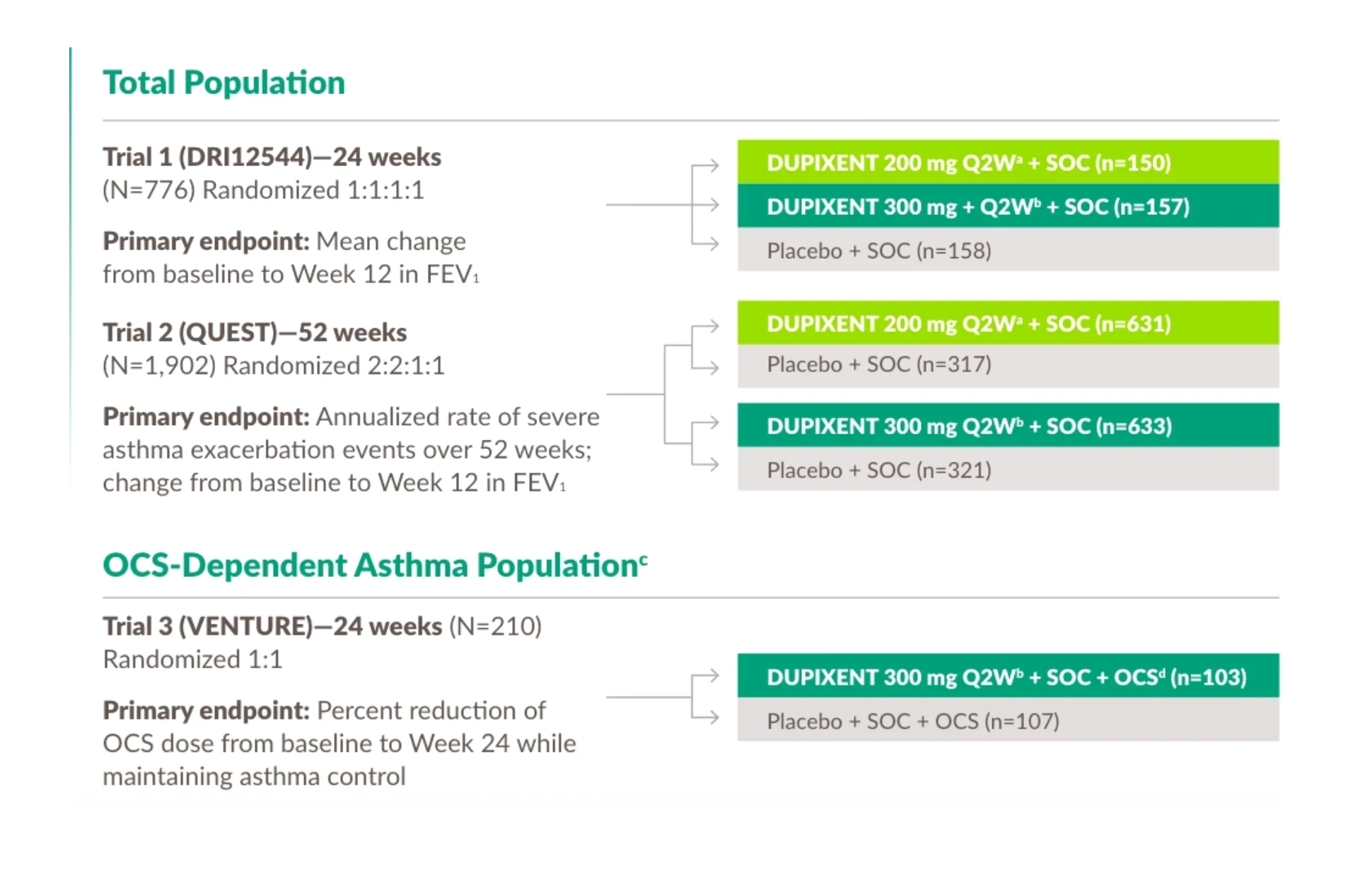
a With 400 mg loading dose.
b With 600 mg loading dose.
c OCS-dependent patients required daily oral corticosteroids, in addition to regular use of high-dose–inhaled corticosteroids plus an additional controller.
d OCS dose was reduced every 4 weeks during the OCS reduction phase (Weeks 4-20), as long as asthma control was maintained.
Adult & adolescent patient characteristics across 3 trials1,22,24,28
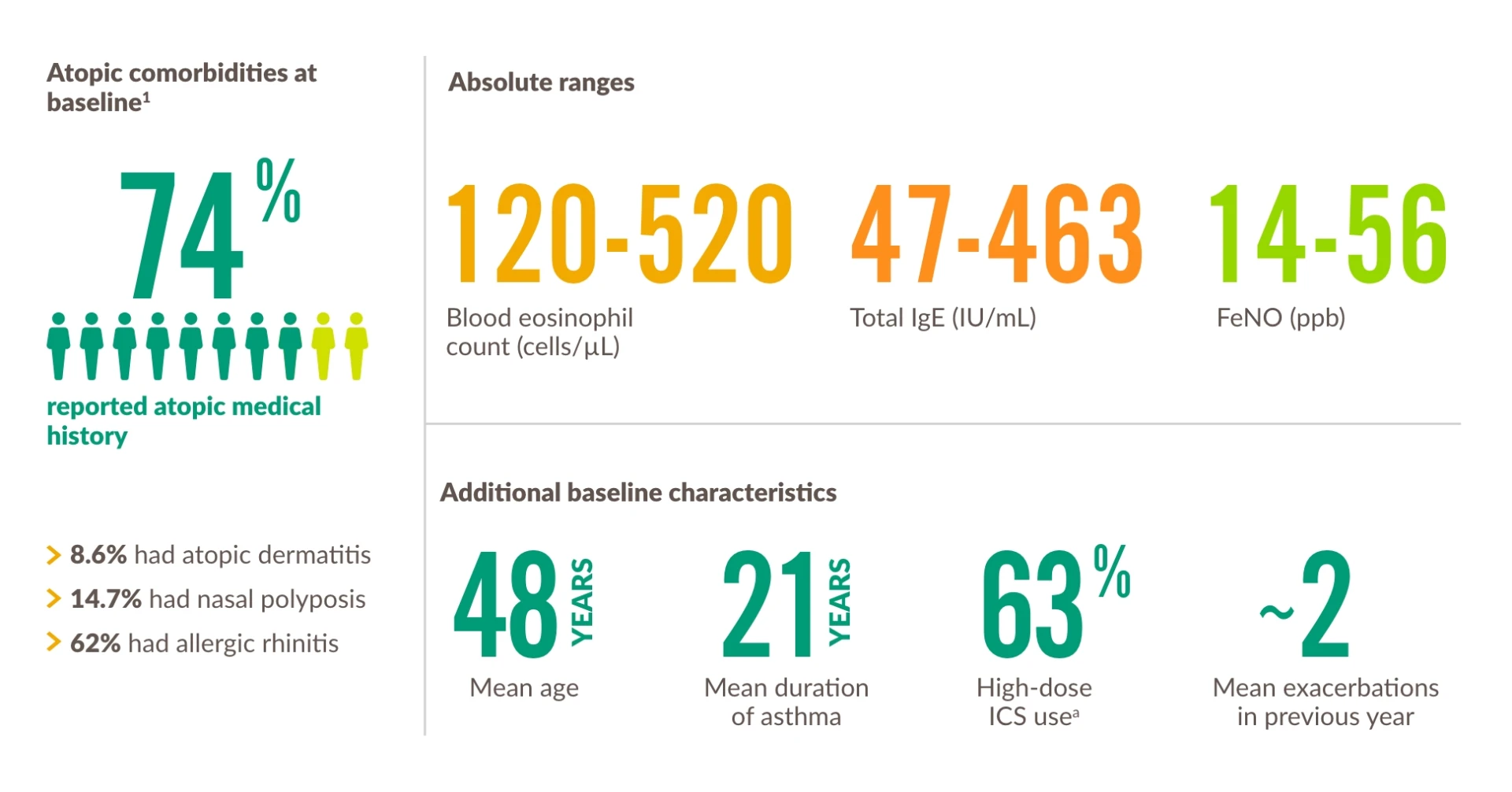
aHigh-dose ICS use across the 3 trials was 49.5% in DRI12544, 51.5% in QUEST, and 88.6% in VENTURE. The population in dupilumab asthma trials included patients on medium- to high-dose ICS. The medium ICS dose was defined as equal to 500 mcg fluticasone or equivalent per day.
Extension trial of patients from DRI12544, QUEST, and VENTURE1,18,19
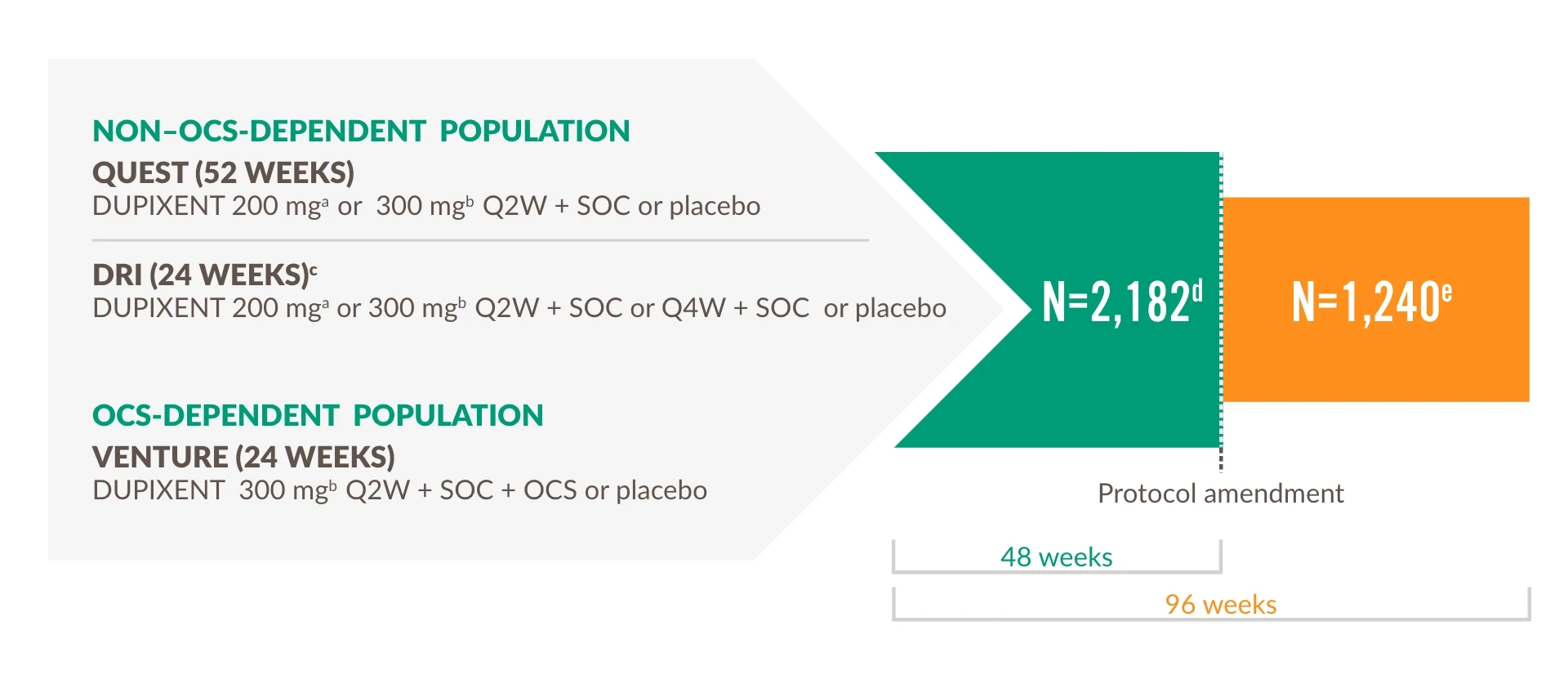
Primary endpoint
The number and percentage of patients with any treatment-emergent adverse events
The LIBERTY ASTHMA TRAVERSE evaluated the long-term safety, tolerability, and efficacy of DUPIXENT in adults and adolescents who enrolled from a previous DUPIXENT study, including DRI12544, QUEST, and VENTURE
Select other endpoints
- Number and annualized rate of severe exacerbation events
- Improvement in FEV1
- In the OCS-dependent population, percent reduction from baseline in OCS dose and proportions of patients achieving ≥50% reduction and completely tapering off OCS
a With 400 mg loading dose.
b With 600 mg loading dose.
c It should be noted that eligible patients completed the 16-week, post-treatment, followup period of the parent study before being rolled over into TRAVERSE.
d Total number of subjects enrolled and exposed to treatment in OLE.
e Total number of subjects who continued to be exposed to treatment beyond 48 weeks.
VESTIGE study is not added yet in to the local label in Kingdom of Saudi Arabia
VESTIGE: the largest study using novel FRI technology with an asthma biologic4
The VESTIGE trial was a phase 4, randomized, double-blind, placebo-controlled study that used functional respiratory imaging (FRI) to evaluate the effect of dupilumab on airway inflammation, as well as structural and functional changes in the lungs. The study population consisted of patients aged 21 to 70 years with uncontrolled moderateto- severe asthma (Asthma Control Questionnaire [ACQ]-5 score ≥1.5), pre-BD FEV1 ≤80% of predicted value, ≥1 exacerbation in prior year, blood eosinophil count ≥300 cells/μL, and FeNO ≥25 ppb.a
Primary endpoints:
- Proportion of patients achieving FeNO <25 ppb at Week 24
- Percent change from baseline to Week 24 in airway volume corrected for lung volume (siVaw) at TLC
Secondary endpoints:
- Change in global mucus score from baseline at Week 24 determined by highresolution computed tomography (HRCT)
- Percent change from baseline to Week 24 in airway resistance
- (siRaw) at TLC
a FRI (functional respiratory imaging) is a novel computational modeling technique that combines high-resolution CT imaging with computational fluid dynamics to create patient-specific 3D models of lung structure and function. Increase in airway volume and decrease in airway resistance revealed by FRI have been shown to mirror spirometry findings, with the added benefit of illustrating the regional distribution of the effects on lung function
ATOPIC DERMATITIS
DUPIXENT is indicated for the treatment of moderate-to-severe atopic dermatitis in adults and adolescents 12 years and older who are candidates for systemic therapy. DUPIXENT is indicated for the treatment of severe atopic dermatitis in children 6 to 11 years old who are candidates for systemic therapy.
ASTHMA
DUPIXENT is indicated in adults and adolescents 12 years and older as add-on maintenance treatment for severe asthma with type 2 inflammation characterised by raised blood eosinophils and/or raised fraction of exhaled nitric oxide (FeNO), who are inadequately controlled with high dose inhaled corticosteroids (ICS) plus another medicinal product for maintenance treatment.
DUPIXENT is indicated in children 6 to 11 years old as add-on maintenance treatment for severe asthma with type 2 inflammation characterised by raised blood eosinophils and/or raised fraction of exhaled nitric oxide (FeNO), who are inadequately controlled with medium to high dose inhaled corticosteroids (ICS) plus another medicinal product for maintenance treatment.
CRS WITH NASAL POLYPS (CRSwNP)
DUPIXENT is indicated as an add-on therapy with intranasal corticosteroids for the treatment of adults with severe CRSwNP for whom therapy with systemic corticosteroids and/or surgery do not provide adequate disease control.
PRURIGO NODULARIS (PN)
DUPIXENT is indicated for the treatment of adults with moderate-to-severe prurigo nodularis (PN) who are candidates for systemic therapy.
EOSINOPHILIC ESOPHAGITIS (EoE)
DUPIXENT is indicated for the treatment of eosinophilic esophagitis in adults and adolescents 12 years and older, weighing at least 40 kg, who are inadequately controlled by, are intolerant to, or who are not candidates for conventional medicinal therapy.
For additional information, please click here for the SmPC.
~6 YEARS OF ESTABLISHED SAFETY IN ASTHMA
DUPIXENT was consistently well-tolerated across adult and adolescent asthma patients, exhibiting a safety profile similar to that observed in pediatric populations1,a
| System Class | Adverse Reaction | Frequencyb |
| Blood and lymphatic system disorder | Eosinophilia | Common |
| Immune system disorders | Angioedemac Serum sickness reaction Serum sickness-like reaction Anaphylactic reaction | Uncommon Rare |
| Skin and subcutaneous tissue disorders | Facial rashc | Uncommon |
| Musculoskeletal and connective tissue disorders | Arthralgiac | Common |
| General disorders and administration site conditions | Injection site reactions (includes erythema, edema, pruritus, and pain) | Common |
| Common adverse events occuring predominantly in atopic dermatitis clinical trials | ||
| Infections and infestations | Conjunctivitis Oral herpes | Common |
| Eye disorders | Conjunctivitis allergicd Keratitisc,d Blepharitisd Eye pruritusd Dry eyed Ulcerative keratititisc,d | Common Uncommon Rare |
a As observed across 3 randomized, placebo-controlled, multicenter trials of 24 to 52 weeks duration (DRI12544, QUEST, and VENTURE), and a 96-week, open-label extension trial (TRAVERSE) and another 3-year open-label extension study (TRAVERSE CONTINUATION), in adult and adolescent patients. The safety profile observed in the pediatric asthma clinical study (a 52-week multicenter, randomized, double-blind, placebo-controlled study [VOYAGE]) was similar to that seen in adults.
b Common (≥1/100 to <1/10); Uncommon (≥1/1,000 to <1/100); Rare (≥1/10,000 to <1/1,000).
c From postmarketing reporting.
d Eye disorders and oral herpes occurred predominantly in atopic dermatitis studies. The frequencies for eye pruritus, blepharitis, and dry eye were common, and ulcerative keratitis was uncommon in atopic dermatitis studies. In adults with moderate-to-severe atopic dermatitis, the safety and tolerability profile of DUPIXENT has been studied for 4 years in an open-label extension study and was demonstrated to be generally consistent with the 52-week data.
PATIENTS OR CAREGIVERS CAN ADMINISTER AT HOME OR YOU CAN ADMINISTER IN OFFICE
Recommended dosing schedules by patient types1:
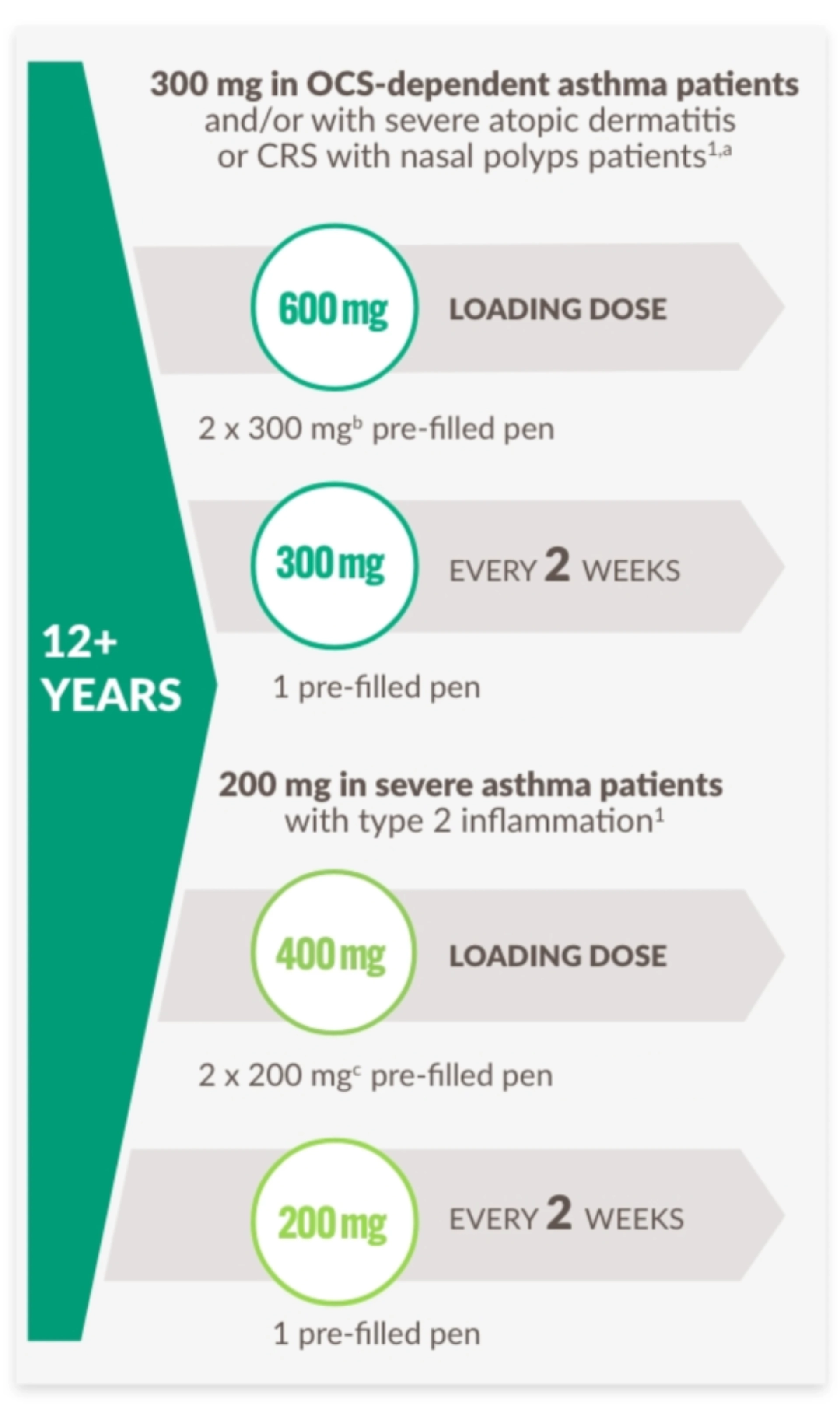
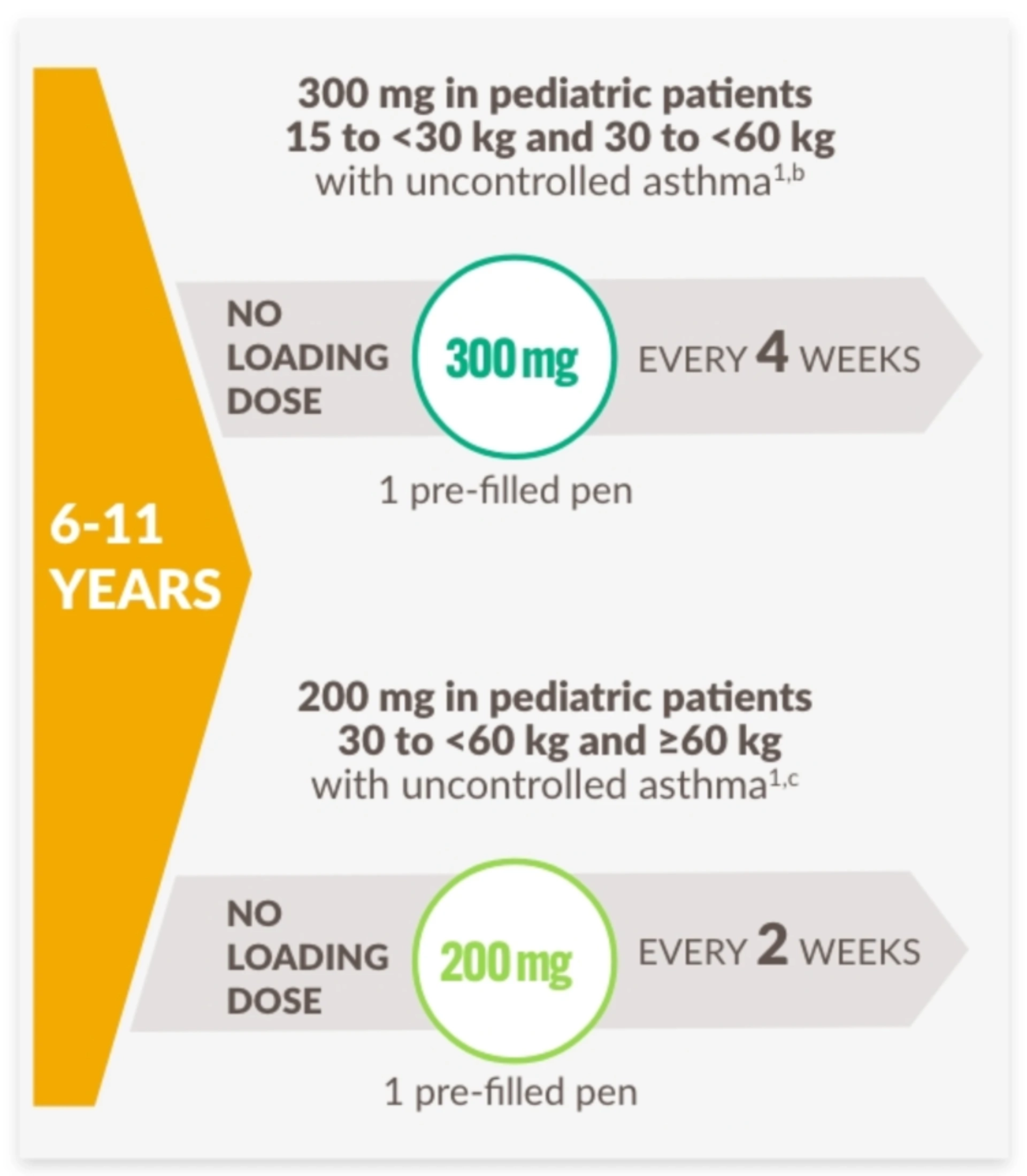
For additional information, please click here for the SmPC.
a Advise atopic dermatitis patients with comorbid asthma not to adjust or stop their asthma treatments without consultation with their physicians. For patients with severe asthma and who are on oral corticosteroids, or for patients with severe asthma and comorbid moderate-to-severe atopic dermatitis or adults with comorbid severe chronic rhinosinusitis with nasal polyposis, use an initial dose of 600 mg (two 300 mg injections), followed by 300 mg every other week, which should be administered as a subcutaneous injection.
b 300 mg=2 mL solution.
c 200 mg=1.14 mL solution.
Administration
DUPIXENT Pre-filled Pen1
- Single-press auto-injector
- A clear 2-step process
- Visual and audible feedback
- Compact and convenient to carry
- Hidden needle
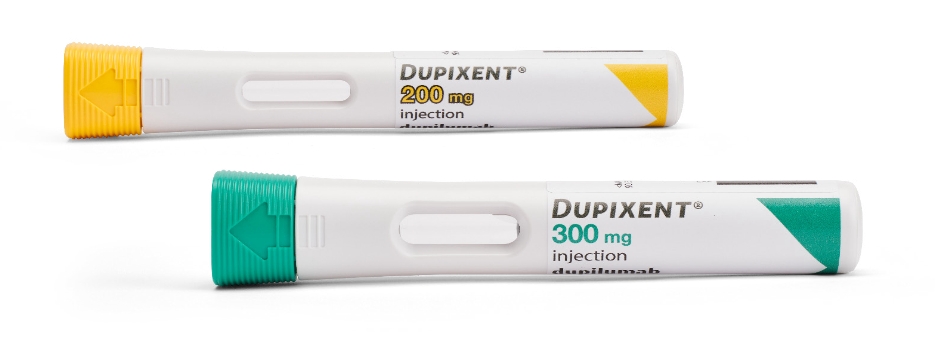
DUPIXENT is intended for use under the guidance of a healthcare provider1
- DUPIXENT can be injected by a patient or caregiver at home after training in a subcutaneous injection technique using the auto-injection pen (for adults and adolescents) or pre-filled syringe
- Physicians or nurses should provide proper training to patients and/or caregivers on the preparation and administration of DUPIXENT prior to use, according to the Instructions for Use
- DUPIXENT can be administered in the office under the guidance of a healthcare provider if the patient or caregiver is not an appropriate candidate to administer the injection
For additional information, please click here for the SmPC.
ACQ-5, Asthma Control Questionnaire, 5-Item version
ACQ-5-IA, Asthma Control Questionnaire-5, Interviewed Administered
ACQ-7-IA, Asthma Control Questionnaire-7, Interviewer Administered
AQLQ(S), Asthma Quality of Life Questionnaire
BD, bronchodilator
COPD, chronic obstructive pulmonary disease
CRS, chronic rhinosinusitis
CRSwNP, chronic rhinosinusitis with nasal polyps
CSU, chronic spontaneous urticaria
CT, computed tomography
ED, emergency department
EoE, eosinophilic esophagitis
EOS, eosinophils
FeNO, fraction of exhaled nitric oxide
FEV1, forced expiratory volume in 1 second
FEF, Forced Expiratory Flow
FRI, functional respiratory imaging
GINA, Global Initiative for Asthma
HCPs, healthcare professionals
HD-ICS, high-dose inhaled corticosteroids
HRCT, high-resolution computed tomography
ICS, inhaled corticosteroids
ILC2, type 2 innate lymphoid cells
ISAR, International Severe Asthma Registry
ITT, intention-to-treat
LABA, long-acting beta agonist
LAMA, long-acting muscarinic antagonist
LSM, least squares mean
LTRA, leukotriene receptor antagonist
OCS, oral corticosteroids
OLE, open-label extension
OR, odds ratio
PAQLQ(S)-IA, Pediatric Asthma Quality of Life Questionnaire with Standardized Activities-Interviewer Administered
PACQLQ, Pediatric Asthma Caregiver’s Quality of Life Questionnaire
PROs, patient-reported outcomes
PSBL, parent study baseline
Q2W, once every 2 weeks
Q4W, once every 4 weeks
QoL, quality of life
SCS, systemic corticosteroid
SE, standard error
siRaw, airway resistance
siVaw, airway volume
SOC, standard of care
TLC, total lung capacity
TSLP, thymic stromal lymphopoietin
-
DUPIXENT Summary of Product Characteristics, 2024.
-
Gandhi NA, Bennett BL, Graham NMH, Pirozzi G, Stahl N, Yancopoulos GD. Targeting key proximal drivers of type 2 inflammation in disease. Nat Rev Drug Discov. 2016;15(1):35-50. doi:10.1038/nrd4624
-
Brusselle GG, Koppelman GH. Biologic therapies for severe asthma. N Engl J Med. 2022;386(2):157-171. doi:10.1056/NEJMra2032506
-
Castro M, Papi A, Porsbjerg C, et al. Evaluating the effect of dupilumab on type 2 airway inflammation and mucus plugging in patients with uncontrolled moderate-tosevere asthma: the VESTIGE Trial. Presented at the Annual Scientific Meeting of the American Academy of Allergy Asthma & Immunology (AAAAI); February 23-26, 2024; Washington, DC.
-
Pavord ID, Bourdin A, Papi A, et al. Dupilumab sustains efficacy in patients with moderate-to-severe type 2 asthma regardless of inhaled corticosteroids dose. Allergy. 2023;78(11):2921-2932. doi:10.1111/all.15792
-
Shah PA, Brightling C. Biologics for severe asthma—which, when and why? Respirology. 2023;28:709–721. doi:10.1111/resp.14520
-
Porsjberg C, Dunican EM, Lugogo NI, et al. Effect of dupilumab treatment on mucus plugging and mucus volume in type 2 asthma: the phase 4 VESTIGE trial. Poster presented at the International Conference of the American Thoracic Society (ATS). May 17-22, 2024. San Diego, CA. Poster A34.
-
IQVIA Sanofi Integrated DUPIXENT Platform, data through August 31, 2024.
-
DUPIXENT Japan PI, 2024.
-
Denton E. Price DB, Tran TN, et al. Cluster analysis of inflammatory biomarker expression in the International Severe Asthma Registry. J Allergy Clin Immunol Pract. 2021;9(7):2680-2688.e7. doi:10.1016/j.jaip.2021.02.059
-
Robinson D, Humbert M, Buhl R, et al. Revisiting type 2-high and type 2-low airway inflammation in asthma: current knowledge and therapeutic implications. Clin Exp Allergy. 2017;47(2):161-175. doi:10.1111/cea.12880
-
Hammad H, Lambrecht BN. Dendritic cells and epithelial cells: linking innate and adaptive immunity in asthma. Nat Rev Immunol. 2008;8(3):193-204. doi:10.1038/nri2275
-
Alving K, Malinovschi A. Basic aspects of exhaled nitric oxide. In: European Respiratory Monograph. European Respiratory Society Publications; 2010;49:1-31.
-
Saatian B, Rezaee F, Desando S, et al. Interleukin-4 and interleukin-13 cause barrier dysfunction in human airway epithelial cells. Tissue Barriers. 2013;1(2):e24333. doi:10.4161/tisb.24333
-
Manson ML, Säfholm J, James A, et al. IL-13 and IL-4, but not IL-5 nor IL-17A, induce hyperresponsiveness in isolated human small airways. J Allergy Clin Immunol. 2020;145(3):808-817.e2. doi:10.1016/j.jaci.2019.10.037
-
Bonser LR, Zlock L, Finkbeiner W, Erle DJ. Epithelial tethering of MUC5AC-rich mucus impairs mucociliary transport in asthma. J Clin Invest. 2016;126(6):2367- 2371. doi:10.1172/JCI84910
-
Lee CG, Homer RJ, Zhu Z, et al. Interleukin-13 induces tissue fibrosis by selectively stimulating and activating transforming growth factor beta(1). J Exp Med. 2001;194(6):809-821. doi:10.1084/jem.194.6.809
-
Wechsler ME, Ford LB, Maspero JF, et al. Long-term safety and efficacy of dupilumab in patients with moderate-to-severe asthma (TRAVERSE): an open-label extension study. Lancet Respir Med. 2022;10(1):11-25. doi:10.1016/S2213- 2600(21)00322-2
-
Sher LD, Wechsler ME, Rabe KF, et al. Dupilumab reduces oral corticosteroid use in patients with corticosteroid-dependent severe asthma: an analysis of the phase 3, open-label extension TRAVERSE trial. Chest. 2022;162(1):46-55. doi:10.1016/j.chest.2022.01.071
-
Maspero JF, Peters AT, Chapman KR, et al. Long-term safety of dupilumab in patients with moderate-to-severe asthma: TRAVERSE Continuation Study. J Allergy Clin Immunol Pract. 2024:12(4)991-997.e6. doi:10.1016/j.jaip.2023.12.043
-
Bacharier LB, Maspero JF, Katelaris CH, et al. Assessment of long-term safety and efficacy of dupilumab in children with asthma (LIBERTY ASTHMA EXCURSION): an open-label extension study. Lancet Respir Med. 2024;12(1):45-54. doi:10.1016/S2213-2600(23)00303-X
-
Bourdin A, Papi AA, Corren J, et al. Dupilumab is effective in type 2-high asthma patients receiving high-dose inhaled corticosteroids at baseline. Allergy. 2021;76(1):269-280. doi:10.1111/all.14611
-
Global Initiative for Asthma. Global strategy for asthma management and prevention, 2024. Accessed June 14, 2024. https://ginasthma.org/wpcontent/uploads/2024/05/GINA-2024-Strategy-Report- 24_05_22.WMS.pdf
-
Rabe KF, Nair P, Brusselle G, et al. Efficacy and safety of dupilumab in glucocorticoid-dependent severe asthma. N Engl J Med. 2018;378(26):2475-2485. doi:10.1056/NEJMoa1804093
-
Tang M, Elicker BM, Henry T, et al. Mucus plugs persist in asthma, and changes in mucus plugs associate with changes in airflow over time. Am J Respir Crit Care Med. 2022;205(9):1036-1045. doi:10.1164/rccm.202110-2265OC
-
Porsjberg C, Dunican EM, Lugogo NI, et al. Effect of dupilumab treatment on mucus plugging and mucus volume in type 2 asthma: the phase 4 VESTIGE trial. Supplementary Results, 2024.
-
Castro, M, Papi A, Porsbjerg C, et al. Effect of dupilumab on airway inflammation and mucus plugs measured with functional respiratory imaging: results from a randomised, double-blind, placebo-controlled study in patients with type 2 asthma (VESTIGE). Lancet. Forthcoming 2024.
-
Castro M, Corren J, Pavord ID, et al. Dupilumab efficacy and safety in moderate-tosevere uncontrolled asthma. N Engl J Med. 2018;378(26):2486-2496. doi:10.1056/NEJMoa1804092
-
Wenzel S, Castro M, Corren J, et al. Dupilumab efficacy and safety in adults with uncontrolled persistent asthma despite use of medium-to-high dose inhaled corticosteroids plus a long-acting ß2 agonist: a randomised double-blind placebocontrolled pivotal phase 2b dose-ranging trial. Lancet. 2016;388(10039):31-44. doi:10.1016/S0140-6736(16)30307-5
CONTACT DETAILS
SANOFI, SAUDI ARABIA ,
TAHLIA STREET, NOJOUD CENTER, GATE C, 1ST FLOOR, P.O. BOX 9874, JEDDAH 21423, SAUDI ARABIA For Medical Information: Please contact:+966126693318 Email:ksa.medicalinformation@sanofi.com,Website: www.sanofi.com.sa
For Pharmacovigilance, Please contact: +966-54-428-4797, ksa_pharmacovigilance@sanofi.com To report any product technical complaints, kindly contact quality.greatergulf@sanofi.com.To report any side effect(s),Saudi Arabia:The National Pharmacovigilance Centre (NPC): SFDA Call Center: 19999 ,E-mail:npc.drug@sfda.gov.sa Website: https://ade.sfda.gov.sa/
.png)
